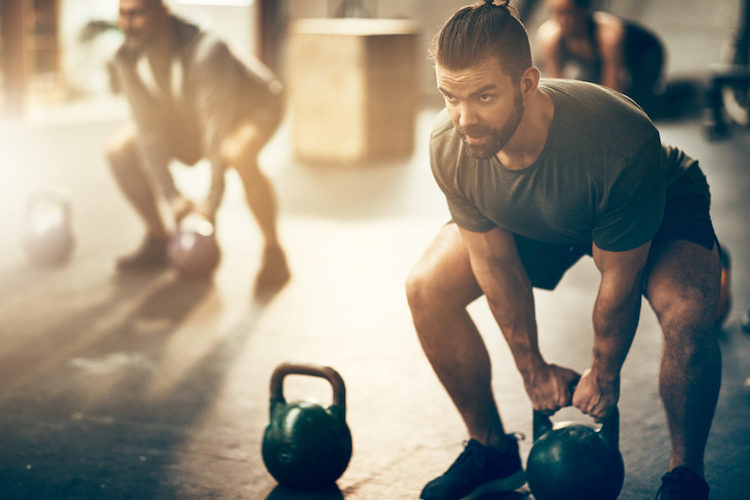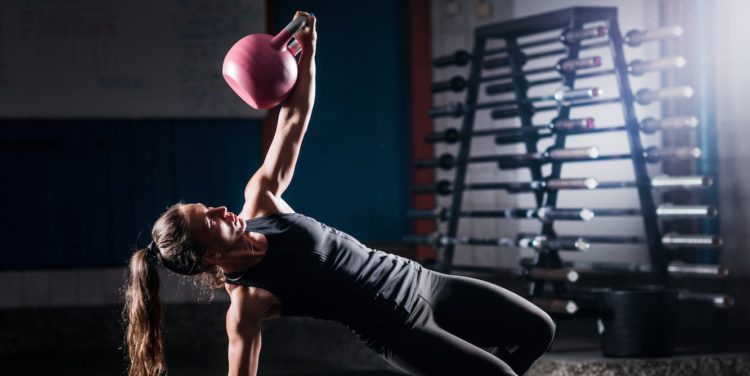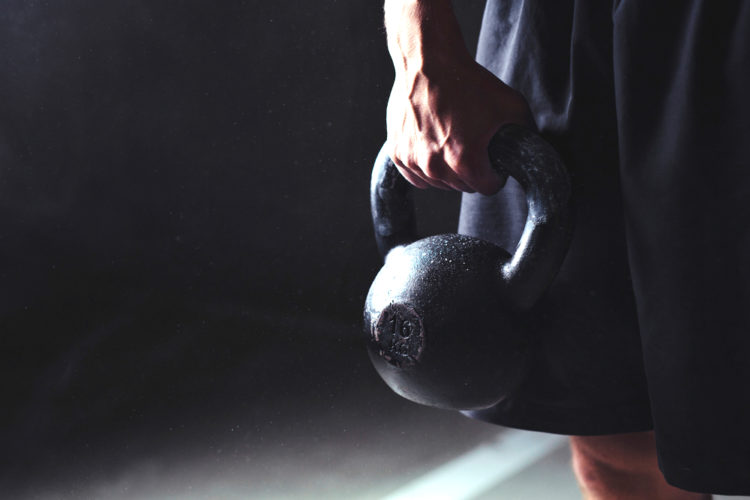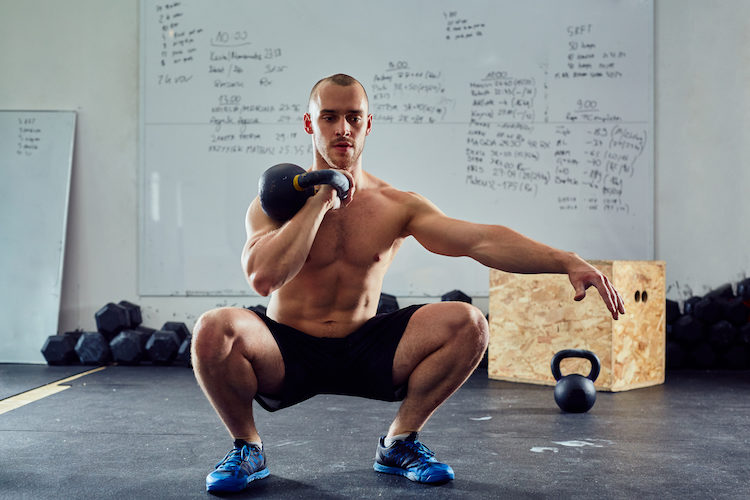So you’ve hit a plateau with your lifts.
Maybe the plateau is physical: your numbers have stopped rising, or weights that normally go up easily are now grinding when they shouldn’t be.
Or your plateau is mental: your lifts are doing just fine, thank you very much, but your brain just doesn’t feel like hitting the gym. You know you’re not overtraining, but you have been lacking variety, and it’s killing your beast mode vibe.
Maybe it’s a bit of both. Whatever’s going on with your lifts — even sans plateau, maybe you’re just in the market for new ways to improve your big three — there are kettlebell circuits out there for you just waiting to give your lifting the boost you’re looking for.

Why Kettlebell Conditioning Helps Your Strength
You might be wondering if all this conditioning work will translate directly into strength and muscle-building, instead of distracting and detracting from your strength goals.
But that’s the awesome thing about kettlebells: they’re great for improving your cardiovascular capacity while also stimulating strength and muscular gains.
According to one 2017 study published in the Journal of Strength and Conditioning Research, 14 participants engaged in different forms of kettlebell swings and had their muscular activation measured by surface electromyography.(1) The study found that kettlebell swings performed with an adequate hip hinge are excellent at activating the medial hamstrings, and pretty darn good at activating the biceps femoris, too. And, as serious strength athletes know, strong hamstrings translate into even more powerful deadlifts.
And it’s not just specific muscle groups that kettlebell conditioning circuits can improve: it’s your overall maximal and explosive strength. According to a 2012 study, also published in the Journal of Strength and Conditioning Research, training for six weeks in twice-weekly, 12-minute bouts of kettlebell swings (30 seconds on, 30 seconds off) dramatically improved participants’ 1RM half-squat and vertical jump height.(2) This translation of kettlebell conditioning into strength and power gains can be very helpful when you’re integrating kettlebell circuits into your lifting program.
If you’re still concerned about the idea that any conditioning-specific work might negatively impact your strength gains, just go a little bit heavier with your kettlebells. Even when the total lifting volume remains the same, kettlebell swing circuits completed with a heavier kettlebell induces a bigger hormonal response (meaning more muscle growth for you) than circuits completed with a lighter bell, according to a 2018 study.(3) Don’t feel the need to go too heavy, though: you want to make sure your muscles are recovering effectively between all your training sessions. Finding that balance always depends on where you are in your program and what your specific goals are right now.
All of the circuits below will boost your cardiovascular conditioning and help up your lifting numbers, but they all have slightly different emphases. All you have to do is select what works best for you, your goals, and your program right now.
[Related: The Ultimate Guide to Conditioning for Powerlifters]

Kettlebell Conditioning Circuit 1: Improving Core Strength
Improving your core strength is only going to help your big three lifts, and since this circuit involves intense regulation of your breath, your metabolic conditioning is going to improve, too.
What does that translate into?
- More cardiovascular energy for submaximal training (which is super important to build up your max), and
- more core strength to spike up max lift numbers.
Because these movements are all very controlled (the double swing may not be slow, but it is certainly a very controlled move), you can challenge yourself by upping the weight here, as long as you have proper form and breathing down.
Turkish Get-Up: 4 full reps, one side
Make sure your movements are slow and that your core is in control of the movement at all times. Keep your wrist straight (not bend backward toward the bell), and make eye contact with the weight at all times. (For help, here’s our guide to this tricky movement.)

Double Kettlebell Swing: 10 reps
Adopt a slightly wider stance than you normally would to accommodate moving two bells at once. Worried about hitting your knees? That’s why your palms will be turned inward, facing each other. If anything knocks on your knees (or inner thighs), it’ll be your forearms. Still not convinced? That’s okay: take an even wider stance (as long as you can still comfortably and successfully hip hinge) until you feel more comfortable. If it takes you a moment to find your balance with this move, that’s normal: the movement will feel more and more natural (but not necessarily easier!) with practice.
Suitcase Carry: 30 seconds, one side
Walk in a slow and controlled manner, with your core tight and your feet deliberately walking in alignment, as though you were on a tightrope. Since there will only be weight in one hand, make sure your shoulders don’t hike up or down to compensate. For maximum effectiveness, try to keep your torso positioned like you’re not carrying anything at all. And remember, because the weight is offset in only one hand, you’ll be doing this with lighter weight than you do with farmer’s carries (with a weight in both hands).
Repeat circuit with your opposite side.
Rest 90 seconds.
Repeat full circuit three times (i.e., three times per side for six total circuits).
[Related: 10 Kettlebell Exercises Every Athlete Should Master]

Kettlebell Conditioning Circuit 2: Hamstrings And Glutes
Ah, the proverbial bread and butter of kettlebell training: the kettlebell swing. In this circuit, you’re going to use different kinds of swings to really rock out your hamstrings and glutes. Remember, emphasize your hip hinge here rather than trying to yank the bell up with your upper body. Keep a neutral back, select moderate weights for each lift, breathe, and you got this.
Kettlebell Swing: 30 seconds
This is the regular kettlebell swing: one bell, both hands. Make sure to set up with a neutral back, and don’t feel the need to grip the bell super tightly. Keep your elbows soft but not bent, and make sure the momentum is coming from your hips.
Double Kettlebell Swing: 30 seconds
This is a hard lift to pull off, but your form will be essentially the same as it is for a regular swing. As noted above, you’ll adopt a slightly wider stance, and you’ll also turn your palms in to face each other so that the bells (and your hands) won’t interfere with each other.
Alternating Kettlebell Swing: 30 seconds
You’ll be a bit winded (and your muscles will be tired) by this point, so form will be especially important. As with any kettlebell swing, resist the temptation to lean back when your hips reach lockout at the top of the swing. Keep your back neutral and avoid that hyperextension, even if it’s tempting. But, it’s okay to internally rotate your shoulder slightly during one-handed swings, when the bell goes behind you. It might make the lift feel smoother for you, and that’s all we want here.
Rest 90 seconds.
Repeat circuit 4 times.
[Related: How to Do Picture Perfect Kettlebell Swings]

Kettlebell Conditioning Circuit 3: Grip Strength
Here’s the trick for this circuit: you’re not going to try not to put the bells down between the circuits. The limiting factor with weight here is going to be the bottoms-up press, so make sure you’re letting that move dictate your weight selection. Otherwise, go hard and be prepared to have your forearms (and fingers) itching to put the bells down.
Bottoms-up Overhead Press: 15 seconds
Since you’re going to try not to put the weight down between circuits, this lift will definitely be your limiting factor in terms of weight selection: hence the shorter lift time. Focus on your form rather than on cranking out a high number of reps here. Let the clock, not rep count, guide you.
Farmer’s Walk: 30 seconds
Just like with suitcase carries, make sure you’re in control of your walking. Keep your torso nice and even, and regulate your breathing as you look straight ahead. And remember that farmer’s walks are with two bells, not one. So as a bonus, you can go heavier!
Double-Handed Kettlebell Swing: 15 seconds
Your forearms will not like you by this point (again, hence the shorter time), so pay extra attention to your form here. Don’t hyperextend your back to try to hike the weights up higher; your low back will thank you later.
Rest for 30 seconds, but try not to put the bells down. Of course, do so if and when you have to, but to really maximize effort and effect here. You want to try to keep hold of them as long as possible. That’s why the rest is shorter here: secretly, it’s another exercise all on its own.
Repeat circuit three times.

Kettlebell Conditioning Circuit 4: Upper Body Development
If your focus is really your bench or overhead press right now, you might be on the hunt for a kettlebell circuit that really puts your upper body to the test. And because all of these moves are unilateral, you’re going to do each circuit with only one side of your body. The first circuit, for example, you might do with your left arm. The next time around, you’re going to complete the circuit with your right arm. Rinse, repeat, and enjoy the upper body burn.
Unilateral Kettlebell Squat to Press: 20 seconds, one side
Make sure you’re getting as deep as you can into your squat, with the bells in comfortable rack position across your delts. Use the momentum of coming out of your squat to press the weights up into an overhead press to polish this move off.
Unilateral Kettlebell Clean: 20 seconds, one side
Make sure you begin the lift with your thumb and index finger holding onto the curve of the handle (rather than gripping the bell’s handle in its center). And start the movement of every rep from the ground with your thumb pointing behind you. Cleaning up (see what I did there?) the way you start this move will help make sure your forearms don’t suffer at the top of the lift.
Unilateral Kettlebell Snatch: 20 seconds, one side
Similar to the clean, make sure you’re starting with an off-set grip and your thumb facing behind you. And again, let your momentum and hip snap bring the bell to the top of the lift, rather than trying to yank the bell up and then letting it flop (painfully) on your forearm.
Rest 90 seconds.
Repeat circuit four times.
[Related: 3 Types of Workouts to Improve Powerlifters’ Work Capacity]
Get Circuit-ing
If you’re new to kettlebells, definitely start slow and light, making sure your form is locked in before trying to amp up the weight. But whatever your experience level with kettlebells, these circuits are going to leave you with a stronger cardiovascular system — and stronger muscles — that you’re going to need when you get back under a barbell.
Don’t forget to breathe, and have fun: that’ll improve your lifts for sure.